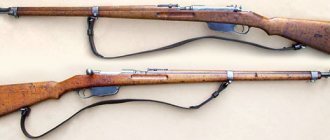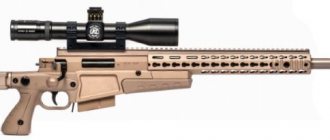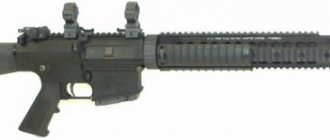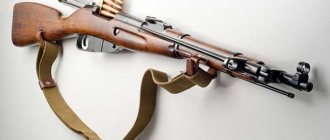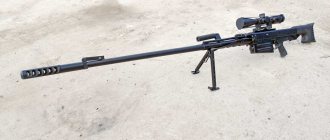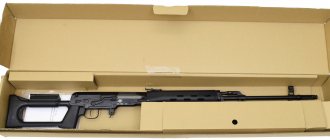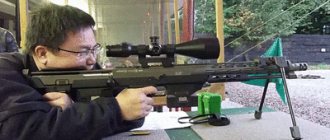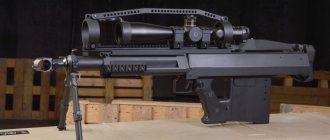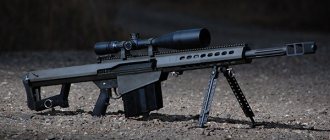Rifles for the country of bankers (part 3)
Through consistent improvements
It must be said that the appearance of the new Swiss rifle is indeed quite unusual. Firstly, the magazine was not located next to the trigger guard, but was placed far forward. Secondly, the details of the shutter were unusual - the ring protruding from the rear, and the barrel-shaped, and, moreover, non-metallic linings on the reloading handle. The barrel was traditionally covered on top with a wooden cover along almost the entire length of the barrel (to the front sight), the neck of the butt was straight, but that was where its similarity with other rifles ended.
Swiss army soldiers on the eve of World War II.
Equally unusual was the direct movement shutter, which operated without turning the handle. It consisted of two parts located next to each other: the bolt itself and a durable long rod with a handle. The bolt consisted of a rotating tube with two combat protrusions located behind a figured groove into which a protrusion on the rod with a reloading handle entered, and a long bolt, inside of which there was a twisted mainspring, a trigger with a ring at the end and a firing pin. The rod was located in the boss of the receiver, and its protrusion entered into the figured groove of the bolt tube. When the rod was moved back by the handle, this protrusion rotated the tube, and the tube also moved back. At the same time, the bolt also rotated, also went back and pulled the cartridge case out of the chamber. When the handle moved forward, everything happened in the reverse order, and the bolt sent the cartridge into the chamber and closed, that is, the bolt stem with the extractor simply rested against the bottom of the sleeve, and the lugs went into the annular groove of the receiver.
The bolt of a 1911 Schmidt-Rubin rifle.
Model 1911 rifle.
The trigger was equipped with a ring, convenient for grasping it with your fingers when setting it to the safety cock or to the combat cock. Typically, the trigger is raised when the bolt rotates at the moment when it is opened and pulled back. The trigger is placed on the safety cock by pulling the ring back and turning it to the right. The rifle has a very easy trigger.
As you can see, the Schmidt-Rubin rifle's bolt has undergone three successive improvements. The Model 1889 shutter (below) is the longest and is believed to be prone to vibration because of this. Its main drawback is its very long length. The 1911 rifle and carbine action became shorter. The combat rests are placed on it differently and more rationally. Finally, the most successful bolt for the 1931 rifle was designed by Colonel Adolf Furrer. It is the shortest, and two lugs are located on the front edge of the rotating bolt tube.
The device of bolts of rifles mod. 1889, 1911 and 1931. As you can see, the metal consumption of each of them consistently decreased along with the length, and strength and reliability only increased.
Schmidt-Rubin K31 rifle. The spring-loaded shutter delay is clearly visible just below the handle. Without moving it down, it was impossible to move the shutter!
The stock is made of solid walnut wood. There is no cleaning rod; instead, a rope wipe is used. The tip of the forend has a crutch for making the rifle into a sawhorse - a traditional part of many rifles of that time.
Cap on the barrel and crutch.
Model 1918 bayonet
The bayonet has a long cleaver blade and is worn in a sheath on the belt. The weight of the bayonet is 430 g. The rifle weighs 4200 g. The length without bayonet is 1300 mm. The Swiss liked the rifle for its rate of fire, capacious magazine, good accuracy when shooting, trouble-free action of the bolt and a well-thought-out trigger mechanism that facilitated accurate shooting. However, the Sun also has spots, and they did note two shortcomings. The first drawback is the very long stem of the shutter. The second drawback stemmed from the first. It was impossible, within the framework of the requirements for a cavalry carbine, to create a weapon for a rider of an acceptable length with such a bolt!
Graphic diagram of the 1911 carbine. From the army manual for use and care.
Carbine or "blunderbuss" 1911.
Sight for the 1911 Blunderbuss.
The Austrians had to take an unconventional path and, having an infantry rifle of one system, adopt a carbine of another, namely the Mannlicher system carbine chambered in their own 7.5 mm cartridge. The carbine was approved in 1893, but its production did not begin until 1895, and only 7,750 were produced. It had a traditional direct-action Mannlicher bolt and a six-round magazine, but was not popular with the Swiss cavalrymen and after ten years of service it replaced by a short Schmidt-Rubin rifle, which was also used by artillerymen and signalmen. Well, and, of course, they immediately began to improve the rifle they liked.
Schmidt-Rubin rifle magazines 1889, 1911 and 1931.
In 1896, the rifling in the barrel was changed and improved and a new sight and stock with a pistol neck were installed. This Schmidt and Rubin rifle was called the 1889/1896 model; and she served in the army until 1930. The bolt on it was somewhat shortened, and the combat lugs were now located in front of the figured groove. 127 thousand produced.
Barrels and bolts of 1911 and 1931 rifles. Obviously, reducing the length of the bolt frame made it possible to increase the length of the barrel while maintaining the same dimensions of the rifle. The new sight arrangement also increased the length of the aiming line.
Then the so-called short rifle of the 1889/1900 model appeared, which was also used as a cavalry carbine. The barrel was shortened to 590 mm, and the magazine capacity was reduced to six rounds. In terms of length and weight, it turned out to be an intermediate model between the 1893 model cavalry carbine and an infantry rifle. The weight of the rifle was 3600 g (while an infantry rifle with a barrel length of 820 mm was 4200 g). 18,750 rifles were produced.
Bolt boxes of 1911 and 1931 rifles.
In 1911, a cartridge with a pointed bullet 7.5×55 GP11 was adopted into service in Switzerland, and therefore the sight on it had to be changed, and the rifle itself had to be changed somewhat. Now, with a bullet weight of 11.2 g and a powder charge of 3.2 g, its bullet speed when leaving the muzzle was 825 m/sec, and at a distance of 25 m – 810 m/sec. The sleeve remained the same, 1889. The barrel had a length of 750 mm. 4 grooves, right stroke, pitch 270 mm. For the barrel, they came up with an original brass cap that was attached to the front sight. The sector sight had divisions from 200 to 2000 m. The magazine, as on the previous model, held six rounds. Moreover, it was also made retrievable. To do this, a spring-loaded latch was installed directly on the right side of the magazine. A rope was used instead of a cleaning rod. It was noted that this rifle could fire up to 24 aimed shots per minute, which was considered a very good indicator.
1911 rifle scope
Rifle model 1889 - 1911. in 1931 it was significantly modernized and, under the designation K31, was in service with the Swiss army from 1933 to 1958.
Blunderbuss K31.
First of all, the changes affected the bolt; it was significantly shortened and strengthened, and its locking lugs were finally installed at the front end of the rotary tube. The receiver accordingly became shorter, lighter and easier to manufacture.
Clip for the K31 rifle and magazine cut-off.
Due to the shortening of the receiver, the barrel became 60 mm longer than the short barrel of the 1889/1911 model rifle. The sight on the barrel was moved back, so that the length of the aiming line increased. In addition, the quality of the barrel was improved, which increased its survivability and improved ballistic characteristics. 582,230 of these rifles were produced. During the same years, a cavalry carbine was also produced (13,300 copies).
Clips for K31 and cartridges for it.
In 1931, a version for snipers was produced - models 1942 and 1943. Produced from 1944 to 1946. (2240 copies). Finally, in 1955, a sniper rifle was released, produced from 1957 to 1959, and produced in the amount of 4,150 copies.
Magazine for rifle and carbine K31.
P.S. Well, what about today? Today, little Switzerland is one of the most militarized states in the world. All men serve in its army; training takes place twice a year; in addition, mobilizations are carried out during natural disasters. It is impossible to “opt out” of the army in Switzerland, but you can “buy off” from it by paying an increased tax and... parting with the opportunity to make a career in the public sector of the economy - those who have not served their country are simply not accepted there. Their Swiss Army System, with some differences, became the basis for the construction of the Israeli army, which has been continuously fighting for almost 70 years. Accordingly, its infantry weapons are very good, and are in service not only in Switzerland itself, but even in the USA.
Swiss soldiers in the mountains in 1917.
PPSh-41
The submachine gun became the first weapon of Season 3. Its characteristics:
- increased rate of fire;
- a fairly large affected area;
- quite manageable recoil pattern for such a rate of fire.
Ideal for mid-range. To win most battles at this range, it is enough to memorize and learn to compensate for the recoil. A significant drawback of the weapon is the large spread when firing from the hip. There is a much greater chance of winning when shooting with a sight. The low speed of the bullet is also not an advantage. When shooting at a long distance, you have to take a fairly large lead margin. Attachments, especially those installed on the barrel, can partially compensate for the problems. With their help you can increase the speed of a bullet.
How to unlock PPSh-41? The developers are ready to give this weapon to everyone who reaches level 15 in the third season of the battle pass.
Sniper rifle The Swiss K31
The most important characteristics of the barrel:
- The bolt action increases accuracy and reduces recoil when using the rifle;
- high reload speed compared to similar rifles;
- low damage in its class, which compensates for the range and mobility of the weapon.
There is no need to be afraid to make a mistake by hitting the enemy in the body instead of the head. The rifle will be ready to try again in a second. The second hit will be decisive. To increase your damage, you can use the Tiger Team 24.9″ attachment. This will increase not only the damage, but also the speed of the bullet and the number of cartridges in the magazine.
How to unlock The Swiss K31? To open it, you don’t need to complete difficult tasks; you just need to reach level 31 in the Season 3 Battle Pass.

